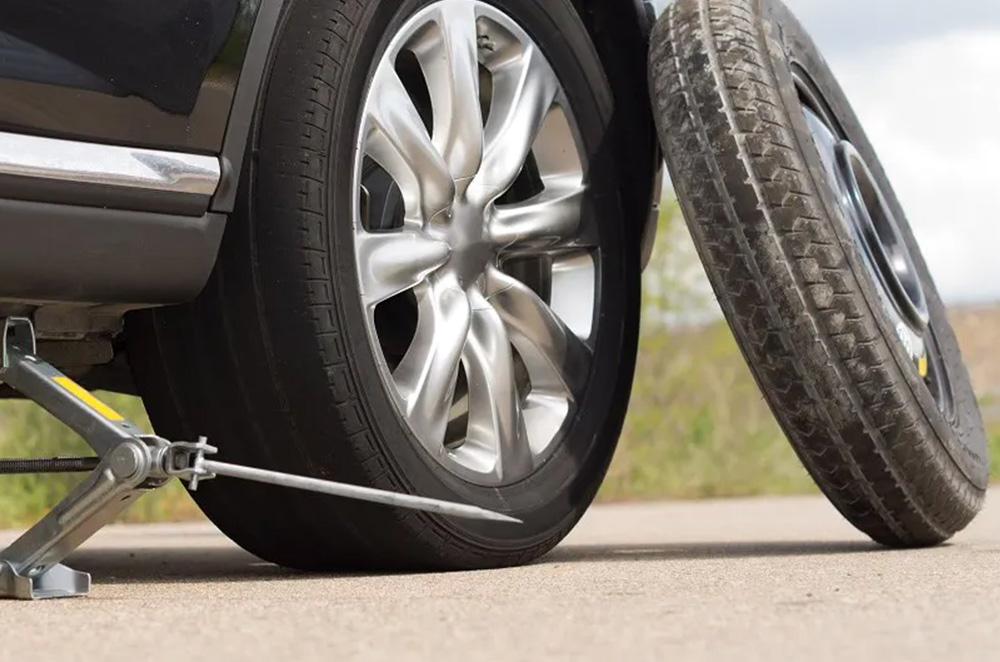
Space-saver tires, also known as donut tires, have long been a staple of the automotive industry. These spares are more compact and cheaper to produce, which bodes well for car companies and consumers. Read on below to find out why cars come with space-saver tires.
History of spare tires

Cars weren’t always packaged with spare tires. The first spares were invented in 1904 by Walter and Tom Davies. Soon after, the Thomas B. Jeffery Company started including spare tires in their cars. These full-size spares were mounted on car exteriors and quickly became part of the aesthetic of the time.
In 1941, however, World War II broke out. The US government quickly banned car manufacturers from producing spare tires for new cars. This ban was due to a worldwide rubber shortage that forced the country to ration supplies. After the war ended, production resumed in full.
Continuous innovation from competing car companies led to the development of the space-saver tire. Introduced in the 1980s by the Volkswagen Automobile Company, this type of spare tire is characteristically smaller, narrower, and has a shallower tread than regular tires. This more compact form factor allowed Volkswagen to save on production costs while giving consumers more room in their trunks.
Following Volkswagen, more and more car manufacturers opted to include donut tires in their cars. Now, space-saver tires are commonplace and invaluable for the automotive industry. In 2017, about half of all new cars produced in the US came with space-saver tires.
When can space-saver tires be used?

Because of their smaller form and lightweight construction, space-saver tires are only recommended for use within short distances. Space-saver tires are designed for emergencies, which means their use is limited to getting you to a repair shop where you can get a full-size tire installed.
When using a space-saver tire, keep in mind that 80 km/h is about as fast as you can go. Going more than a few hundred kilometers on a donut tire is also not recommended. The main reason is that the size and construction of the space-saver spare will negatively affect handling. Space-saver tires have shallower treading and inferior rubber compound, which means that traction is limited and therefore easier for drivers to lose control while using them. Space-savers may also interfere with the braking system and transmission. The imbalance between the regular and space-saver tires may put extra strain on the drivetrain and cause your car to veer off course under hard braking. You may also notice that donut tires typically come in a bright color, usually yellow or orange, to discourage drivers from using the spares for long stretches.
Some of the positives of using a space-saver tire include increased fuel efficiency and lower emissions. However, these changes are not significant enough to warrant using space-saver tires daily.
All in all, space-saver tires are an incredibly useful invention that has helped countless people out of emergencies and mishaps. They're cheaper, lighter, and they maximize trunk space. Although great for shorter distances, space-savers should never be used full-time. Space-saver tires have their time and place, and that is as a temporary spare when there are no other options.
Latest Features
-
Which Chery should I buy? / Featured Article
Chery’s revamped lineup features six vehicles, each with its unique strengths. Not sure which one’s right for you? We’re here to help you decide.
-
The difference between wax and polish / Tips & Advice
Confused about whether your car needs a wax or polish? This article will guide you on what they are and what to choose for your car.
-
The 6 things every Ford Ranger must pass before it leaves the factory / Featured Article
Every Ford Ranger, from the base model to the Ranger Raptor, goes through a full inspection process before it leaves the factory. This includes six steps that make sure it’s ready to drive a...
Popular Articles
-
Cheapest cars under P700,000 in the Philippines
Jerome Tresvalles · Sep 02, 2024
-
First car or next car, the Ford EcoSport is a tough package to beat
Jun 18, 2021
-
Car Maintenance checklist and guide – here’s everything you need to know
Earl Lee · Jan 12, 2021
-
Most fuel efficient family cars in the Philippines
Bryan Aaron Rivera · Nov 27, 2020
-
2021 Geely Okavango — Everything you need to know
Joey Deriquito · Nov 19, 2020
-
Family cars in the Philippines with the biggest trunks
Sep 20, 2023
-
Head to head: Toyota Rush vs. Suzuki XL7
Joey Deriquito · Oct 28, 2020
-
Why oil changes are important for your car
Earl Lee · Nov 10, 2020
-
2021 Kia Stonic — What you need to know about it
Joey Deriquito · Oct 16, 2020
-
Top 7 tips for buying a used car in the Philippines
Joey Deriquito · Nov 26, 2020



